
views
X
Expert Source
Damaris Vega, MDBoard Certified Endocrinologist
Expert Interview. 11 November 2020.
Eat more fruits, vegetables, and whole grains.

These foods are high in fiber, moderate in fat, and contain healthy carbs. Though simple carbohydrates are not recommended for those with high blood pressure, complex carbohydrates like bananas, oatmeal, and sweet potatoes provide necessary nutrients like fiber. Adding these to your diet reduces your risk of high blood sugar, as they are digested much slower than simple carbohydrates. This prevents a quick rise in blood sugar levels. Fresh apples, dried apricots, or peaches canned in juice or water are good choices. Avoid canned or frozen fruits that have added sugar. At least 3 cups (700mL) of raw vegetables or 1.5 cups (350mL) cooked vegetables every day are recommended. Try artichokes, cucumbers, or salad greens. Oatmeal and barley are especially good whole grain options for most people with high blood sugar.
Reduce your intake of simple carbohydrates.
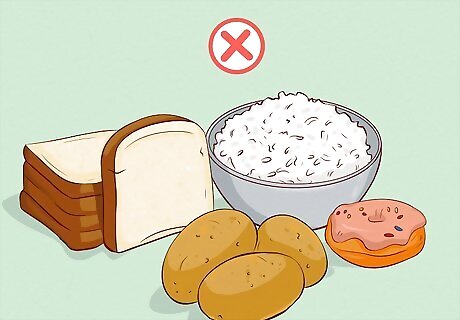
Food and beverages like soda, french fries, and white rice are digested at a faster rate. As your body quickly absorbs the energy they provide, your blood sugar levels rise. This can prompt insulin resistance, which prevents the cells in your body from responding to insulin production. To lower your blood sugar levels, try cutting back on simple carbs so that they are just an occasional treat rather than a significant part of your diet. More examples of simple carbohydrates include pizza, white potatoes, potato chips, and pasta.
Check foods according to the Glycemic Index.
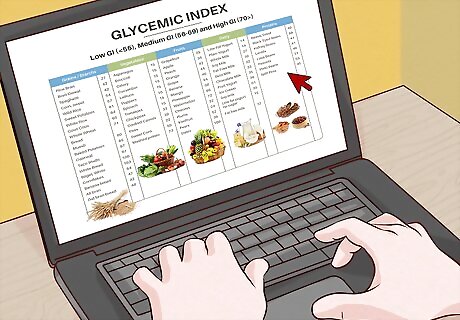
The glycemic index ranks carbs based on how they affect blood sugar levels. Ranging from 0 to 100, the scale lets you know how quickly and how much a certain carbohydrate raises blood sugar levels. If you have high blood sugar or are diabetic, it’s best to avoid foods with a glycemic rating of 70-100. Foods like these, such as white bread, are digested too fast and cause blood sugar levels to rise. Stick to foods with a low glycemic rating of 55 or below to lower your blood sugar. Use https://glycemicindex.com/ or other trusted online indexes to determine the glycemic rating of a particular food.
Cut down on alcohol.
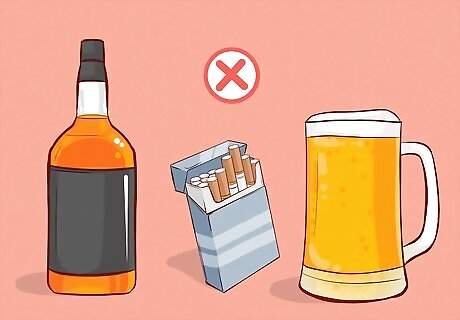
Drinking in excess affects your body’s ability to produce insulin. Specifically, too much alcohol can cause inflammation to the pancreas, which impairs your body's ability to emit insulin. It can also increase your risk of diabetes. To drink in moderation, stick to one to two drinks per day at most.
Quit smoking.
Nicotine has a similar effect as alcohol on your body’s insulin production. Tobacco products increase your blood sugar and increase your risk of diabetes. It can also cause insulin resistance, a condition in which the cells in your body no longer respond to the insulin your body produces. To prevent these complications and lower your blood sugar levels, quit smoking. Use resources like https://smokefree.gov/ and https://lung.org to find more information about how to quit smoking. These websites can also help you come up with a personalized treatment plan.
Manage stress to lower blood sugar.
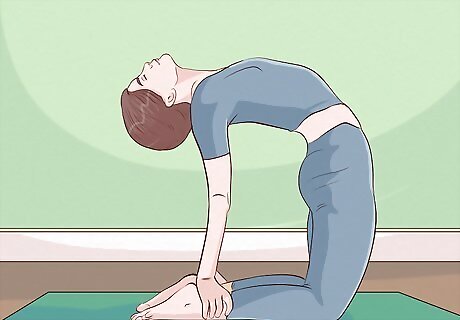
Chronic stress releases hormones that prevent insulin from working properly. The stress hormone Cortisol negatively affects your body's production of insulin and increases your blood sugar levels. It can also lower your immune system, contributing to worsened symptoms if you have diabetes. To lower your stress levels, try activities like mindfulness exercises, deep breathing, meditation, and yoga.
Exercise regularly.

Exercise has direct benefits in reducing blood sugar levels. Exercise helps convert glucose into energy, makes your body's cells more sensitive to insulin, and reduces excess fat, which is associated with high blood sugar. The more active you are, the less likely you are to have problems with high blood sugar. After consulting your doctor, aim for at least 30 minutes of moderate exercise a day, for at least 5 days a week. In total, you should exercise 150 minutes or more each week. Try to find an exercise that you enjoy; this way you will be more likely to stick with it in the long run. Fast walking, swimming laps, or bicycling are all fantastic choices. If you have diabetes or are at risk for diabetes, make sure your exercise regimen is not causing health problems. If you feel faint, have chest pain, feel short of breath, or notice blisters or pain in your feet, stop and call your doctor.
Check your blood sugar levels before exercise.
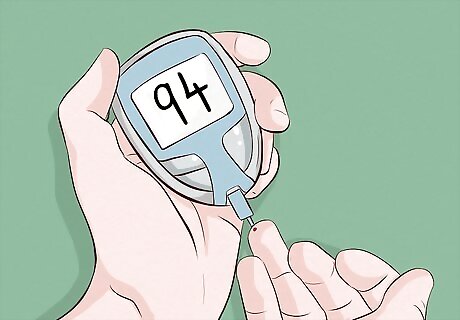
Exercising can temporarily increase your blood sugar. Strenuous activity and exercise encourage your body to produce glucose (sugar) to fuel your muscles. Check your blood sugar levels before you exercise to make sure that it is at a safe level to begin working out.A doctor or drugstore can provide you with a blood glucose meter or testing strip for testing your blood sugar. If your blood sugar is lower than 100 mg/dL (5.6 mmol/L), raise your blood sugar before exercising. A small snack containing carbohydrates should accomplish this, such as fruit or crackers. If the test result is between 100 and 250 mg/dL (5.6–13.9 mmol/L), no action is required unless your doctor instructed you otherwise and you are welcome to exercise. Perform a ketone test if your blood sugar is above 250 mg/dL (13.9 mmol/L). Test your urine for ketones using a ketosis test strip from a drugstore. Don't exercise if ketones are present, and test often if ketone levels are moderate or high. If your blood sugar is higher than 300 mg/dL (16.7 mmol/L), do not exercise. Wait for 30–60 minutes without eating, and test again to see if your blood sugar has dropped to a level that is safe for exercise.
Know what factors can affect your blood sugar levels.

Be aware of how, when, and why your blood sugar fluctuates. Even if you follow a strict diet and exercise plan, your blood sugar levels may change unpredictably, especially if you have diabetes. Blood sugar levels tend to rise in an hour or two following a meal. Blood sugar levels decrease in the long run through physical exercise, which transfers glucose from your blood to your cells. Menstrual cycles cause fluctuations in both hormones and blood sugar levels. Almost all medications influence blood sugar levels. Be sure to check with your doctor before beginning any new medication.
Work with your doctor.
A doctor can recommend a diet, exercise, and medication plan based on your needs. Doctors examine your blood sugar levels, weight, and lifestyle to determine what will effectively lower your blood sugar. Though general guidelines are available to modify your diet and exercise routine, it's important to always talk to a doctor before making any big life changes. This is especially true if you are overweight or have medical conditions like diabetes. Based on your condition, a doctor provides details like the best time of day to exercise, what specific exercises will be most effective, and what exercises should be avoided. Doctors may prescribe insulin injections or other medication to help manage blood sugar levels throughout the day. Visit your doctor or doctor-recommended nutritionist regularly to check on progress and keep an eye out for possible health problems that result from high blood sugar.



















Comments
0 comment